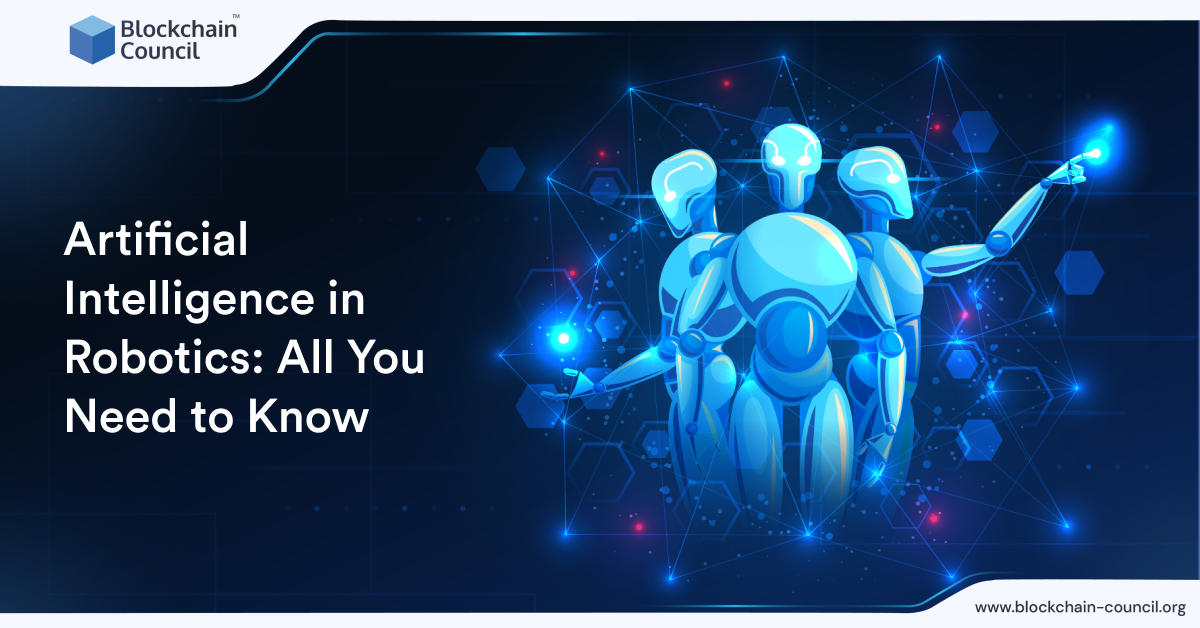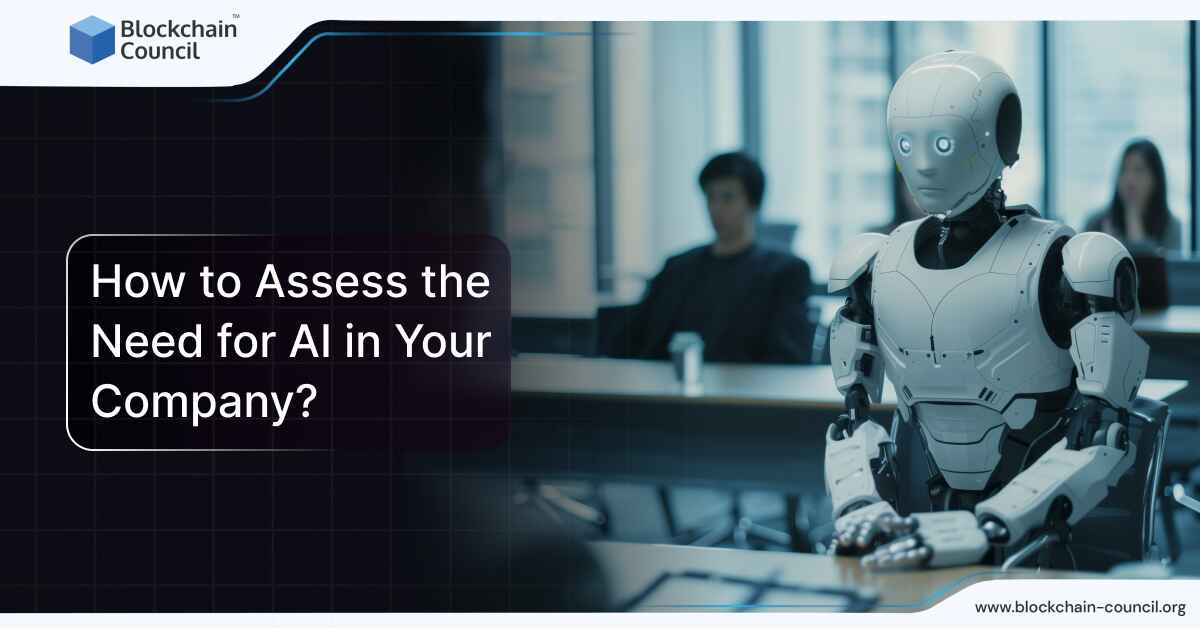
- Blockchain Council
- September 17, 2024
Summary:
- Artificial intelligence (AI) has made it possible to create robots that can somewhat come close to what a human is like.
- AI-controlled robots are being used in manufacturing, pharmaceutical, and other industries to perform various tasks.
- AI-controlled robots are being used in manufacturing, pharmaceutical, and other industries to perform various tasks.
- AI is a simulation of human-like intelligence achieved through natural language processing, machine learning, expert systems, speech recognition, and machine vision.
- AI in robotics aims to provide better interpretation and less human reliance on robots.
- Four primary functions that AI is teaching robots are: vision, grasping, motion control, and data collection/interpretation.
- AI improves the interpretation of sight for robots, enabling them to detect patterns and visualize the moves of objects.
- AI helps robots to grasp objects based on distance and orientation detection, without requiring human support.
- AI embedded in robot systems enables efficient motion control through vision, space detection, edge detection, and other technologies.
- AI allows robots to collect and interpret data, making them self-reliant and able to find the most optimal methods to perform tasks.
- Robotics and AI are being used in various industries, such as manufacturing, healthcare, retail, and agriculture, to perform tasks efficiently and with precision.
Did you know that there is a humanoid robot that can reciprocate human intelligence and even shows some expressions? Well, artificial intelligence has made it possible to make robots that somewhat come close to what a human is like. Robotics and artificial intelligence have been closely linked for a long time. The manufacturing sector has been making use of AI-controlled robots to perform various tasks. In a car manufacturing unit, some robots fit various parts of a car through carefully controlled methods. The controls are all given to AI which assesses the conditions of the workpiece given and based on that performs the tasks. Similarly, pharmaceutical companies manufacture drugs and other medical products with the help of AI-controlled robots.
But why is it that AI has become such an important component of robotics? Well, that is something that we are here to study and ponder. Robots were first created in the 1950s and were the tools that just helped with normal manufacturing tasks. Since then, the field of robotics has seen a lot of evolution. From primitive machines that did the same tasks on a loop, to a full-fledged humanoid robots, there is significant growth in robotics. Now, the use of stats, machine learning, and NLP has made robots to be able to achieve human-like interpretation. The robots can now respond to various stimuli and act according to the conditions. All of this happens through the use of huge data sets and the successful integration of machine learning.
There are a lot of things that go on in the back end of designing a robot and integrating AI into it. You must be intrigued to understand how a robot can get human-like intelligence. Well, we are going to dive deep into understanding artificial intelligence in robotics and what is the role it plays.
What is Artificial Intelligence?
Before going directly into AI in robotics, we should at least have some basic idea of what artificial intelligence is. It is a term that has been heard by people globally but very few know the actual meaning of it. Artificial intelligence stands for an algorithm or program that lets a device achieve human-like interpretation, analysis, and intelligence. The machine gets a lot of data that gets processed by the algorithm and the output is efficiently produced according to the user of the device.
One of the best examples of AI is the use of google maps. Whenever you have to go from one place to another, you check the route through Google Maps. Based on your past driving activities, the road conditions, traffic situation, and the weather, google maps suggest you the best route and even gives you an approximate time of arrival. All of this has happened because of the algorithm that the software makes use of to interpret the data provided to it and generates a user-specific output.
So, it can be concluded that artificial intelligence is the simulation of human-like intelligence with the help of a carefully coded algorithm. It makes use of natural language processing, machine learning, expert systems, speech recognition, and machine vision to achieve such levels of intelligence. If you are interested in the field of artificial intelligence, you can even take up the courses available on the internet, offered by a lot of famous universities and companies. Artificial intelligence has found its application in a lot of industries and has become an ally for their functioning.
Artificial Intelligence in Robotics
Let us now get into the actual topic of what artificial intelligence is doing in the field of robotics. The primary function of AI in robotics is to provide better interpretation and less human reliance on robots. If robots can perform various tasks with their understanding and produce efficient results, then it makes the job even easier for humans. Artificial intelligence is mainly being used to teach four of the important functions to robots. You should know what these four primary functions are to understand what AI is doing in robotics.
Let’s take a look at the four functions that AI is teaching to all the robots for getting human-like intelligence:
Vision
Artificial intelligence makes use of an algorithm that improves the interpretation by sight for the robots. With the use of AI, the robot achieves the capability to detect patterns whenever it is at work. It even visualizes the moves of the object that is in front of the robot. The most impressive thing about the whole detection through vision is that robot can detect patterns that it has never encountered before. AI helps to smoothen the output as compared to conventional robotics and the robot can perform the tasks based on the interpretation of the patterns.
Grasping
Another basic function of a robot is to hold or grasp objects. With the help of AI, robots can be taught to grasp objects based on the distance and orientation detection that the vision already provided. The AI makes sure that the robot does not require any kind of human support to grasp objects. In some cases, AI even lets the robots get a very strong grip by analyzing the points that provide the best grip.
Motion Control
You might have heard of motion-controlled home cleaning robots. They are created with an efficient use of AI embedded into their system. AI makes use of vision, space detection, edge detection, and various other technologies to provide great motion control to the robot. The robot can figure out the best path for itself through the analysis of the surrounding. Moreover, if there are some other motions involved, the machine learning mechanism helps the robot to move in the required manner.
Data
Lastly, but most importantly, AI lets a conventional robot to be able to collect and interpret data. A conventional robot just moves with the support of a user at the back end. But AI helps a robot to become self-reliant with the help of strong data processing and analysis. So, if a robot is deployed in the industrial field, it collects data about what tasks have to be done and then finds the most optimal methods to do the job.
Become a Certified AI Developer Today!
Robotics and AI in Various Industries
Now we know that robotics and AI have become closely related and AI helps robots to become much more efficient and capable. A lot of industries have thus started to make use of AI-enabled robots that make their jobs easier. Artificial intelligence, with the help of expert systems, machine learning, and data processing, makes sure that the robots are performing similarly to or even better than what a human would do.
Let’s take a peep into what the industries are using AI in robotics for:
Healthcare
One of the biggest markets of AI in robotics is the healthcare industry. The interpretation and analytical power of AI are helpful in closely diagnosing patients and even performing various complex procedures. AI-controlled robots are being used in operation theatres to do operations that doctors might not be able to do so precisely. Moreover, AI in robotics is helping in diagnosing various health conditions and how the patients are affected. The machine learning driven tasks of robots are helping in function learning, research, surgeries, testing, diagnosis, and many other areas. Moreover, AI is being used to create a continuous chain of patient management and their requirements.
Agriculture
Now you might be thinking about how AI in robotics is helping in the field of agriculture. Well, AI-controlled robots can take quick surveys of the fields and according to the input of weather, soil conditions and the kind of crop to be cultivated in the land, it can provide a proper insight into what will be the best course of action for the farmers. In some cases, AI-controlled tractors, tillers, and other machines are also being introduced to the field. This reduces the reliance of cultivation on humans. Moreover, AI supports agriculture by updating farmers about various soil and weather conditions. Even AI-controlled irrigation systems are getting popular nowadays.
Automobiles
AI in robotics was initially started because of the functions required in the automobile sector. There are AI-controlled RC cars, dirt bikes, and even go-carts that are being used for entertainment purposes. Then there are AI-controlled trucks and heavy-duty vehicles that are being used to transport materials from one place to another. The need for AI for such vehicles is the hazardous conditions that the vehicles work in during transport. In the case of a deep-dug coal mine, the transportation is highly toxic, and therefore AI controls the trucks and other heavy-duty vehicles to do the work. In automobile manufacturing hubs, a lot of tasks like assembly, screwing, fitting, etc are done by AI-controlled robots. There are many other tasks as well that AI supports performing.
Hospitality
We talked of a humanoid robot that resembled the humans as closely as it could. Well, it falls under the hospitality sector and is being used to accompany humans in various tasks. Hotels and restaurants are now using AI-controlled robots to perform the tasks like managing the room allotment chain, guest management, being a waiter, etc. The hospitality industry requires AI in robotics to do tasks in a much more efficient manner and reduce human reliance. Hotels are also using AI-controlled robots for cleaning, cooking, maintenance, and a lot more.
Also read: Machine Learning Vs Artificial Intelligence
How is AI used in Robotics?
We have discussed what is AI, the role of AI in robotics, and the use cases of AI in robotics. The last and most important aspect to discuss is how robotics and artificial intelligence are linked together. AI can be used in three ways when it comes to applications in robotics.
Based on what the robots are being used for, the AI algorithm is designed and applied to the machine. This makes sure that the whole functioning of the robot is smooth and does not backfire under any scenario.
The three ways that AI is being used in robotics are:
Weak Artificial Intelligence
If the robots are being used for primitive tasks like assembly in a manufacturing unit, cleaning, maintenance work, etc then the use of weak artificial intelligence is enough. It is given such a name because the algorithm designed in such a case is primitive and does not require much critical thinking. The algorithm consists of predefined commands and outputs over various conditions. A basic simulation of human thought and interaction is performed with the use of weak intelligence. Here, the robot does not interpret the data provided to it. It just gives an output based on the pre-defined outputs that are based on the input by the user. Alexa, Siri, and Google Assistant are some of the best examples of weak AI being used in robots.
Strong Artificial Intelligence
Now the application of AI in robotics where the robots need to understand the data input and process it to give the most optimal output starts. Strong AI is being used in cases where robots have to perform tasks based on their interpretation of the data input and the surroundings. Self-driving cars and humanoid robots are the best examples of what strong AI can do in robotics. The AI makes sure that the machine can understand what input is being given to it and then performs the tasks according to the understanding. Robotic surgeons are also an example of strong AI being used in robotics.
Specialized Artificial Intelligence
Such an AI is used for cases where the robots have to do the same task under different conditions. The robot just interprets the data given to it and then performs the task accordingly. Such AI in robots is used in manufacturing units where the robots have to do the same job again and again.
Conclusion
We have discussed all the topics related to artificial intelligence in robotics. We started with the understanding of artificial intelligence and ended up on how different types of AI are being used to make robots more advanced. The field of AI in robotics is vast and interesting. There are many applications of this sector as industries now demand more and more AI-enabled products. You can create your career in this field and gain fast growth. You will just need to have proper knowledge of AI and gain experience through hands-on projects. So, if you are interested in the field of AI in robotics, you can start learning more about it. For now, this guide is enough to have a basic idea about what AI is in robotics.
Frequently Asked Questions
Artificial intelligence (AI) is an algorithm or program that enables a device to achieve human-like interpretation, analysis, and intelligence. It uses natural language processing, machine learning, expert systems, speech recognition, and machine vision to simulate human-like intelligence.
The primary role of AI in robotics is to provide better interpretation and less human reliance on robots. AI is being used to teach robots four primary functions: vision, grasping, motion control, and data collection and interpretation. With the help of AI, robots can achieve human-like intelligence and perform various tasks efficiently.
AI helps robots achieve human-like intelligence by processing large amounts of data through algorithms and using technologies such as natural language processing, machine learning, expert systems, speech recognition, and machine vision. AI enables robots to detect patterns, grasp objects, have motion control, and collect and interpret data.
AI-controlled robots are being used in various industries, such as car manufacturing and pharmaceuticals. In a car manufacturing unit, robots fit various parts of a car through carefully controlled methods, while in pharmaceuticals, AI-controlled robots are used to manufacture drugs and other medical products.


































































 Guides
Guides News
News Blockchain
Blockchain Cryptocurrency
& Digital Assets
Cryptocurrency
& Digital Assets Web3
Web3 Metaverse & NFTs
Metaverse & NFTs
